分析技术研习室

课题组每周研讨会
参考资料
- pheatmap包的Document
- pheatmap介绍:https://www.jianshu.com/p/42c643a43a1f#fn3
- 相关系数矩阵包介绍:https://www.jianshu.com/p/b76f09aacd9c
- 色块控制:https://www.jianshu.com/p/6b765e83d723
- 配色:https://www.jianshu.com/p/e50babec45cb
R包工具
可以绘制热图的包有很多,这里列举一下
- pheatmap::pheatmap (常用热图)
- stats::heatmap(基本热图)
- gplots::heatmap.2 (基本增强热图)
- ComplexHeatmap (适用于基因组分析的复杂热图)
- ggplot2::ggplot(ggplot可视化)
-
heatmaply::heatmaply(交互式)
- ……
为什么做热图?
- 热图可以直观上通过颜色深浅来呈现多个变量之间的关系或者区别
- 热图可以呈现出多变量聚类结果
基本元素
- 数据预处理
- 热图主图参数
- 注释内容(显著性;图例)
解决问题
- 色块控制(热图红蓝色块问题,数字大小和正负值问题)
- 显示部分热图
- 标记相关系数热图显著性
- 数值差异太大热图区分不明显
- 配色
pheatmap包
1. 简单介绍
pheatmap包中的pheatmap函数能够对输入数据进行 k-means聚类和层次聚类,但是数据的行数超过1000时无法进行聚类。
2. 函数参数
pheatmap(mat, color = colorRampPalette(rev(brewer.pal(n = 7, name =
"RdYlBu")))(100), kmeans_k = NA, breaks = NA, border_color = "grey60",
cellwidth = NA, cellheight = NA, scale = "none", cluster_rows = TRUE,
cluster_cols = TRUE, clustering_distance_rows = "euclidean",
clustering_distance_cols = "euclidean", clustering_method = "complete",
clustering_callback = identity2, cutree_rows = NA, cutree_cols = NA,
treeheight_row = ifelse((class(cluster_rows) == "hclust") || cluster_rows,
50, 0), treeheight_col = ifelse((class(cluster_cols) == "hclust") ||
cluster_cols, 50, 0), legend = TRUE, legend_breaks = NA,
legend_labels = NA, annotation_row = NA, annotation_col = NA,
annotation = NA, annotation_colors = NA, annotation_legend = TRUE,
annotation_names_row = TRUE, annotation_names_col = TRUE,
drop_levels = TRUE, show_rownames = T, show_colnames = T, main = NA,
fontsize = 10, fontsize_row = fontsize, fontsize_col = fontsize,
angle_col = c("270", "0", "45", "90", "315"), display_numbers = F,
number_format = "%.2f", number_color = "grey30", fontsize_number = 0.8
* fontsize, gaps_row = NULL, gaps_col = NULL, labels_row = NULL,
labels_col = NULL, filename = NA, width = NA, height = NA,
silent = FALSE, na_col = "#DDDDDD", ...)
3. 数据处理(这里先创建矩阵)
> library(pheatmap)
> # Create test matrix
> test = matrix(rnorm(200), 20, 10)
> test[1:10, seq(1, 10, 2)] = test[1:10, seq(1, 10, 2)] + 3
> test[11:20, seq(2, 10, 2)] = test[11:20, seq(2, 10, 2)] + 2
> test[15:20, seq(2, 10, 2)] = test[15:20, seq(2, 10, 2)] + 4
> colnames(test) = paste("Test", 1:10, sep = "")
> rownames(test) = paste("Gene", 1:20, sep = "")
> head(test, 5)
Test1 Test2 Test3 Test4 Test5 Test6 Test7 Test8
Gene1 2.9506296 0.04980323 3.385544 1.1669879 1.885813 -0.9771256 3.112077 -0.6027554
Gene2 2.0099044 0.51020937 4.011563 0.2758383 5.311161 -0.5104894 1.078437 1.2681561
Gene3 3.8667236 -1.00110670 1.763909 -0.4958210 2.814205 0.9438923 2.238253 2.6206316
Gene4 2.1241335 -0.17389532 3.381439 0.9546686 5.046722 -1.5613329 2.322061 -1.4255754
Gene5 0.2062854 0.45703810 3.471799 -1.2390113 2.333674 -1.0852306 3.996635 -0.8064933
Test9 Test10
Gene1 3.365981 -1.257651534
Gene2 0.727328 -0.004095374
Gene3 5.569084 0.020165678
Gene4 2.413953 -0.644605108
Gene5 2.838279 -0.004935564
4. 画热图
- 默认参数
> pheatmap(test)
参数都没有设置,聚类是默认的,默认同时对矩阵数据的行和列聚类,可以单独设置仅仅对行或者列聚类。
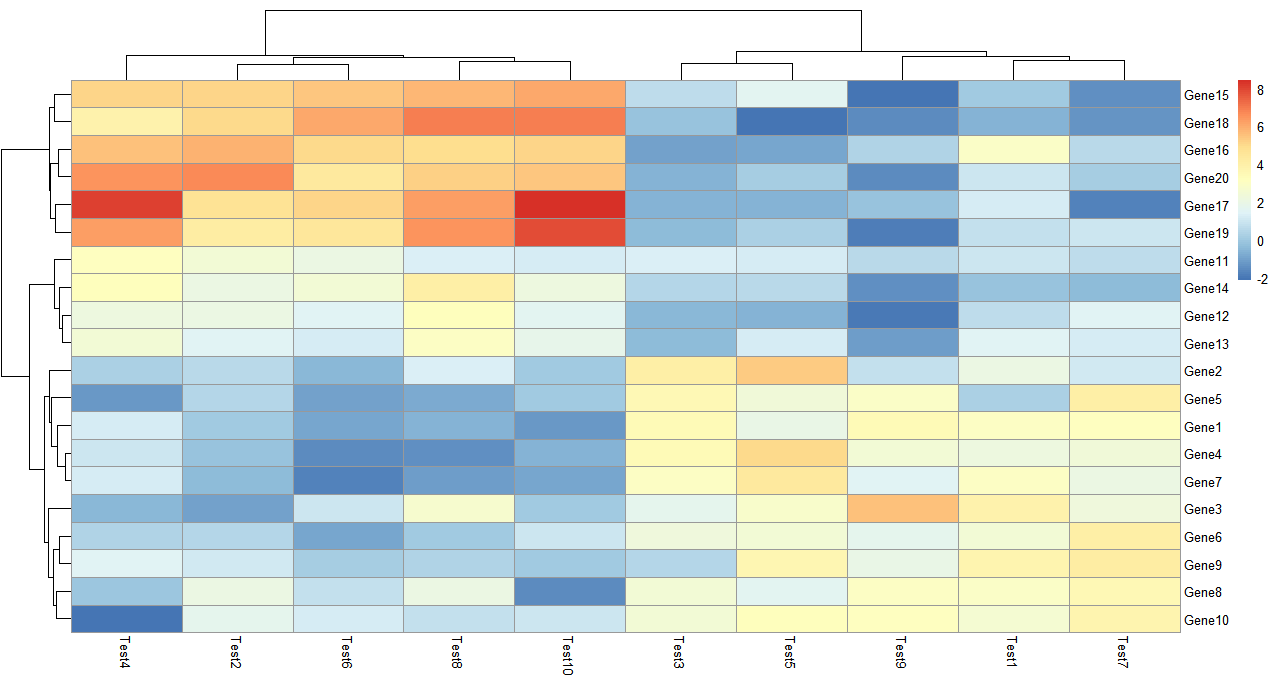
> pheatmap(test, cluster_row = FALSE)
参数需要设置布尔值,cluster_row = FALSE 即不对行聚类
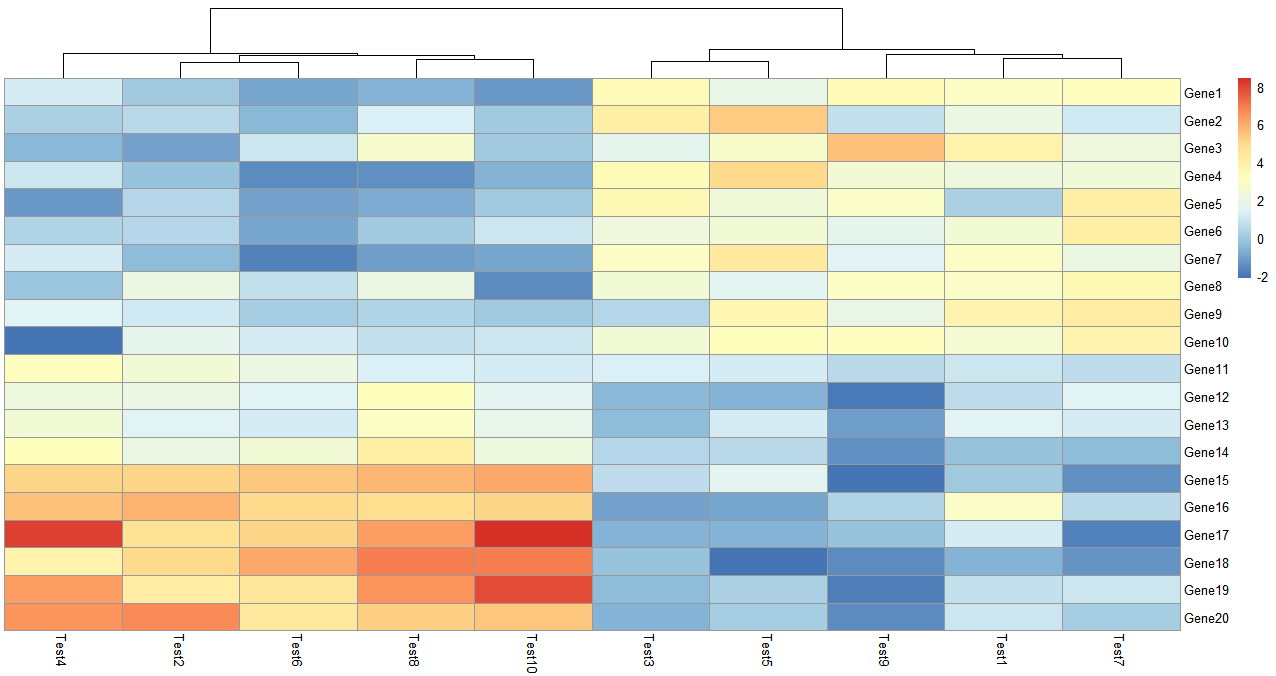
- K-means聚类
> pheatmap(test, kmeans_k = 2)
k means聚类可以自己设置聚类数,聚完类会自动显示聚类中包含多少个变量,在图上没有直接显示类中的具体变量,但是可以通过查看热图列表得到这个信息。
> test_k <- pheatmap(test, kmeans_k = 2)
> cluster <- test_k$kmeans$cluster
> cluster
Gene1 Gene2 Gene3 Gene4 Gene5 Gene6 Gene7 Gene8 Gene9 Gene10 Gene11 Gene12 Gene13
2 2 2 2 2 2 2 2 2 2 2 1 2
Gene14 Gene15 Gene16 Gene17 Gene18 Gene19 Gene20
1 1 1 1 1 1 1
可以进一步提取聚类中包含的变量
> cluster_1 <- names(cluster[which(cluster == 1)])
> cluster_1
[1] "Gene12" "Gene14" "Gene15" "Gene16" "Gene17" "Gene18" "Gene19" "Gene20"
> cluster_2 <- names(cluster[which(cluster == 2)])
> cluster_2
[1] "Gene1" "Gene2" "Gene3" "Gene4" "Gene5" "Gene6" "Gene7" "Gene8" "Gene9" "Gene10"
[11] "Gene11" "Gene13"
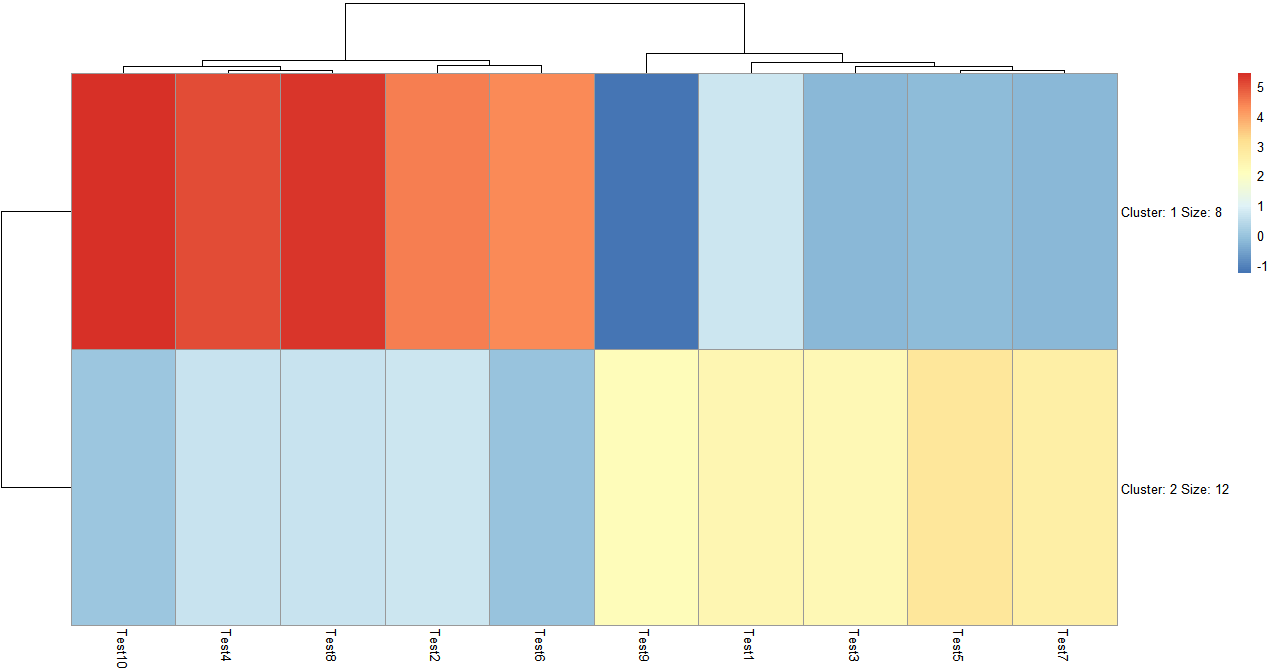
- 归一化和聚类依据
单独设置行或列的聚类依据,这里的依据是皮尔逊系数,改参数可以选择:'correlation', 'euclidean', 'maximum', 'manhattan', 'canberra', 'binary', 'minkowski'
这里还做了归一化处理,可以看到随着数据范围的变化,色块指代的内容也发生了变化
> pheatmap(test, scale = "row", clustering_distance_rows = "correlation")
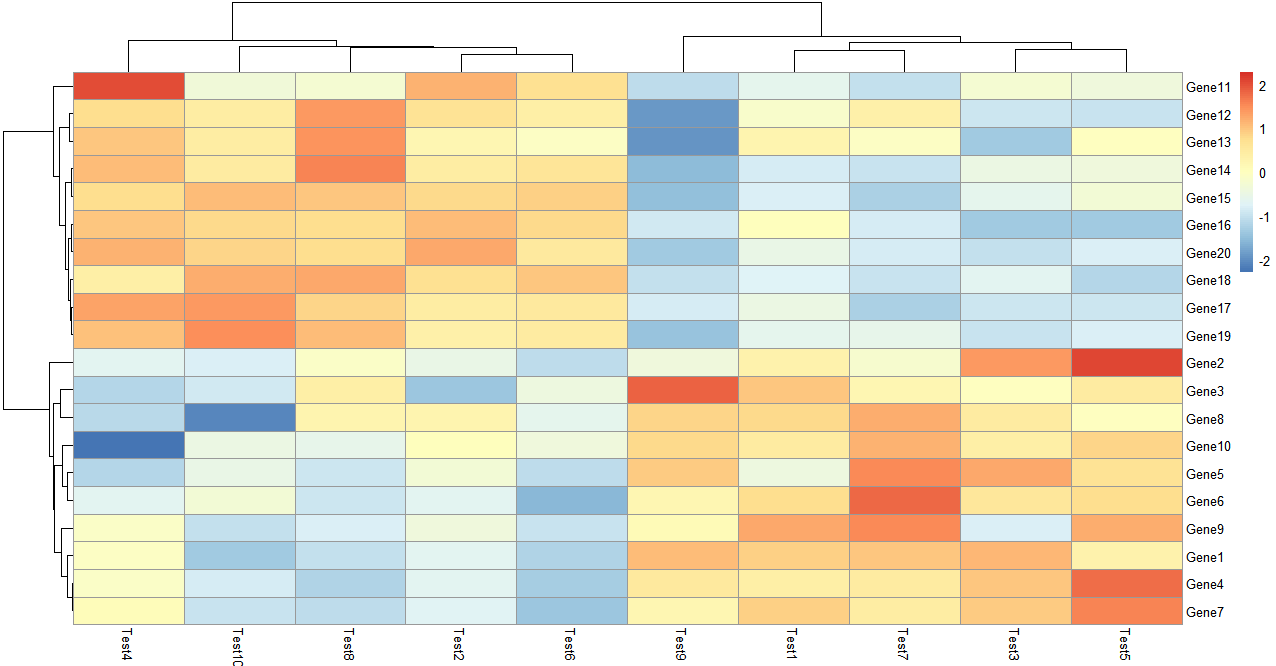
- 颜色设置
可以看一下这个colorRampPalette取了50个色来标注数据之间的关系和区别
colorRampPalette的数值设置的越大,颜色越多样,数据差距就能越清晰的反应出来
> pheatmap(test, color = colorRampPalette(c("navy", "white", "firebrick3"))(50))
> colorRampPalette(c("navy", "white", "firebrick3"))(50)
[1] "#000080" "#0A0A85" "#14148A" "#1F1F8F" "#292994" "#343499" "#3E3E9F" "#4848A4" "#5353A9"
[10] "#5D5DAE" "#6868B3" "#7272B9" "#7C7CBE" "#8787C3" "#9191C8" "#9C9CCD" "#A6A6D2" "#B0B0D8"
[19] "#BBBBDD" "#C5C5E2" "#D0D0E7" "#DADAEC" "#E4E4F2" "#EFEFF7" "#F9F9FC" "#FDFAFA" "#FBF1F1"
[28] "#F9E8E8" "#F7E0E0" "#F5D7D7" "#F3CECE" "#F1C5C5" "#EFBCBC" "#EDB3B3" "#EBAAAA" "#E9A2A2"
[37] "#E79999" "#E59090" "#E38787" "#E17E7E" "#DF7575" "#DD6C6C" "#DB6464" "#D95B5B" "#D75252"
[46] "#D54949" "#D34040" "#D13737" "#CF2E2E" "#CD2626"
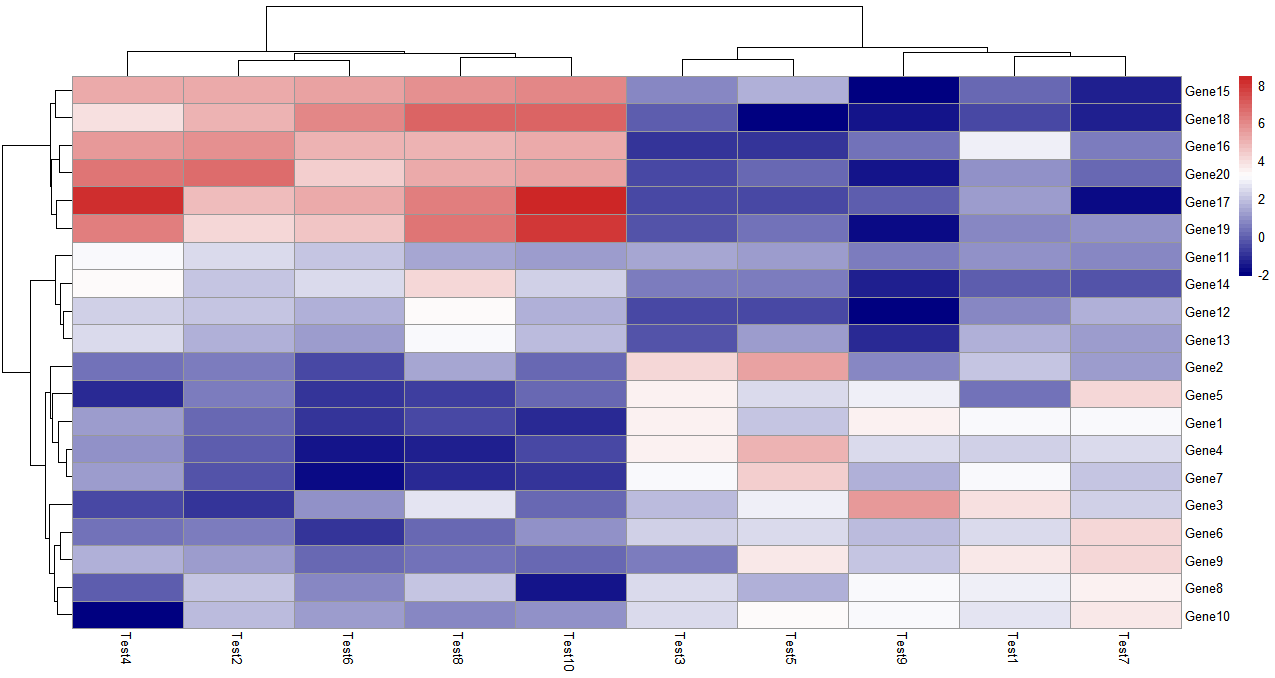
- 层次聚类方式
> pheatmap(test,clustering_method = "ward")
clustering_method可选的参数包含'ward', 'ward.D', 'ward.D2', 'single', 'complete', 'average', 'mcquitty', 'median' or 'centroid',这些都是层次聚类里面类间距离的计算方法。
legend = FALSE
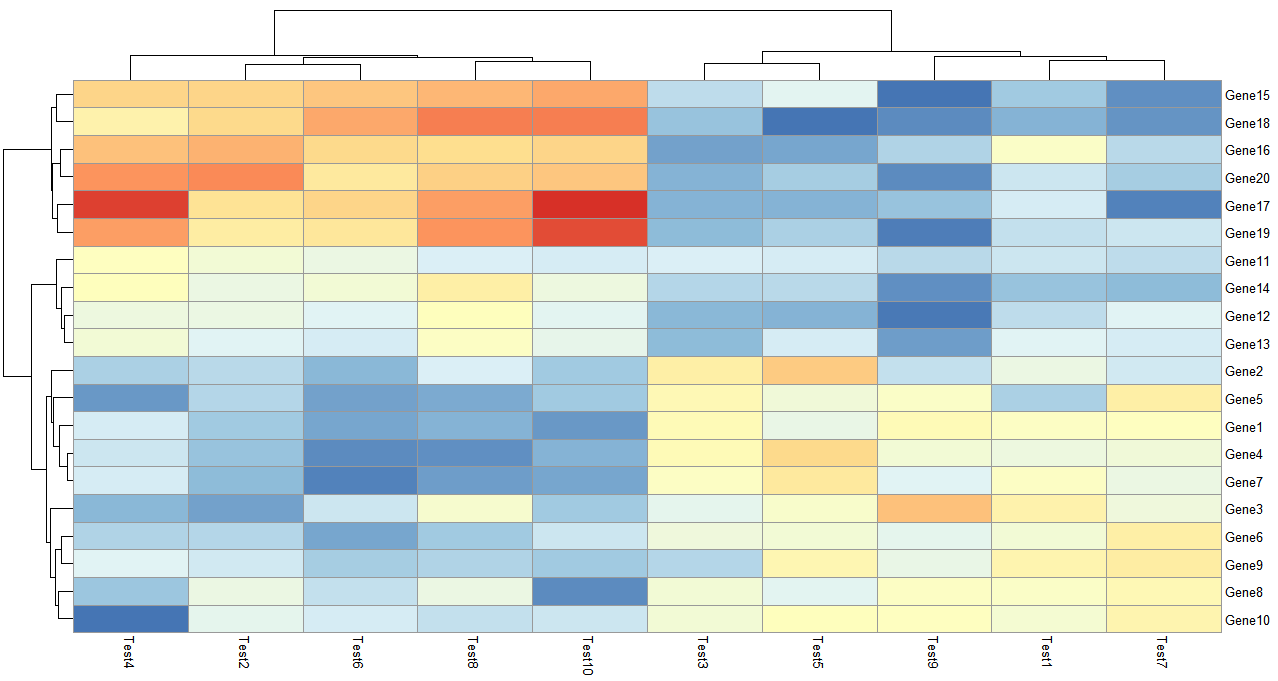
> pheatmap(test, cluster_row = FALSE, legend_breaks = -1:4, legend_labels = c("0",
"1e-4", "1e-3", "1e-2", "1e-1", "1"))
这里自定义设置legend范围在-1到4之间,标签设置成这6个数,可以把自己想看的范围设置在某种颜色区间,一目了然。
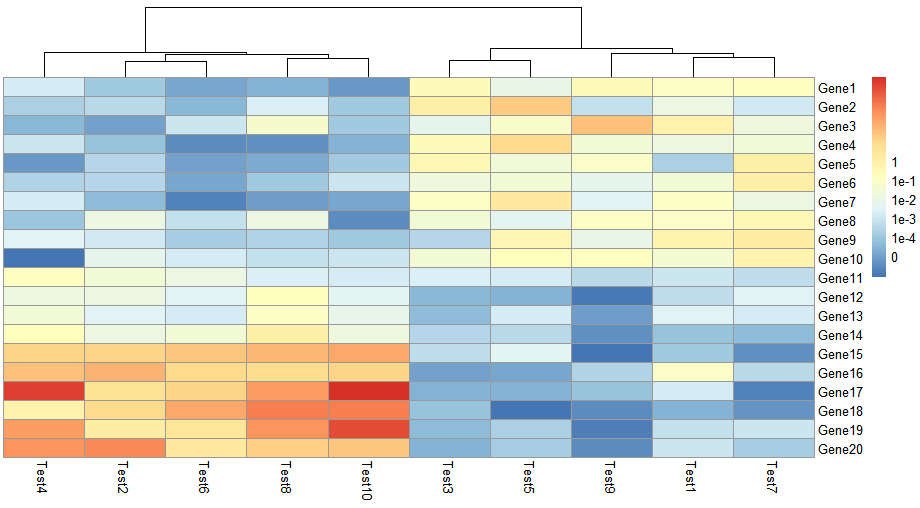
- 色块内部信息
> pheatmap(test, display_numbers = TRUE)
> pheatmap(test, display_numbers = TRUE, number_format = "%.1e")
显示矩阵信息,数值很大很小的时候可以添加参数设置 number_format = "%.1e", 以科学计数法显示内容
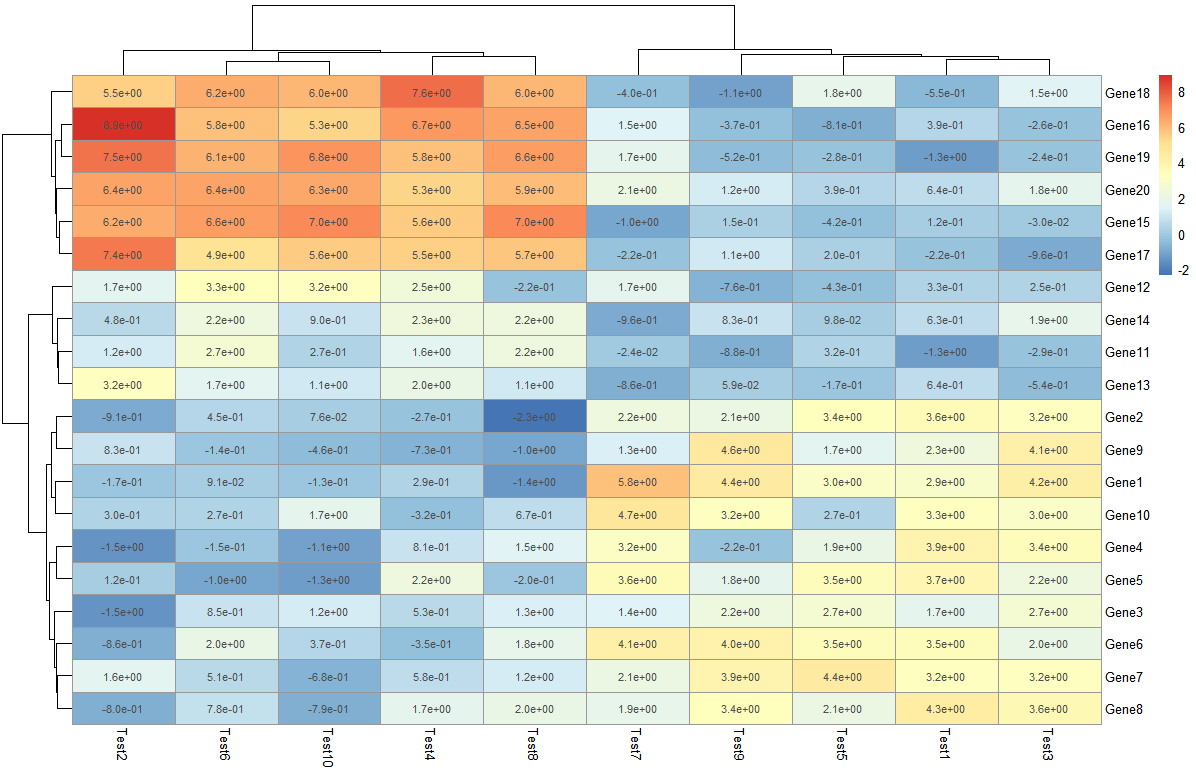
> pheatmap(test, display_numbers = matrix(ifelse(test > 5, "*", ""), nrow(test)))
在这里对原来的矩阵进行处理,构建了新的矩阵存储标记情况,大于5的标记上 *****,如果是使用相关系数做的热图,可以采用这种方式添加显著性标记。
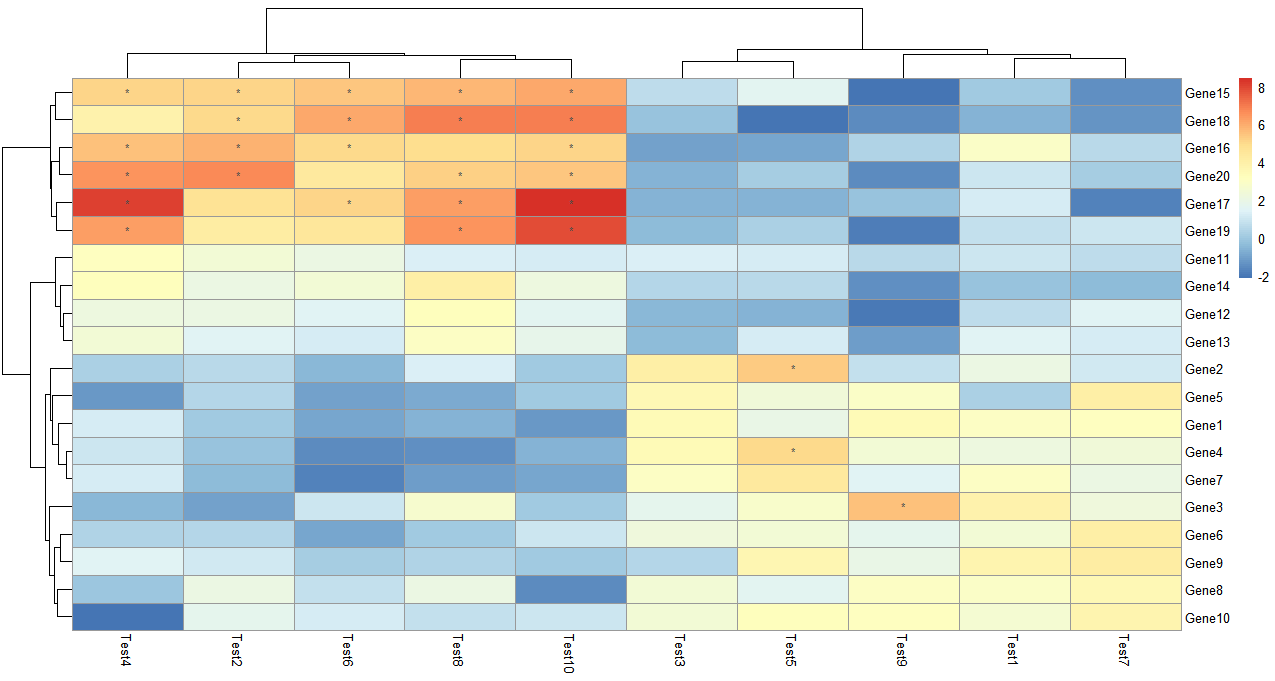
- 设置热图以及字体大小和标题内容
> pheatmap(test, cellwidth = 15, cellheight = 12, fontsize = 8, main = "Example heatmap", filename = "test.pdf")
cellwidth设置热图长,cellheight设置热图高,main设置主题,fontsize设置所有的字体,filename设置热图
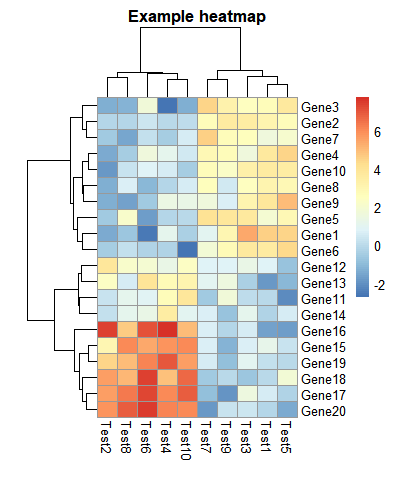
5. 对热图注释
- 创建行列的注释信息
> # Generate annotations for rows and columns
> annotation_col = data.frame(
+ CellType = factor(rep(c("CT1", "CT2"), 5)),
+ Time = 1:5
+ )
> rownames(annotation_col) = paste("Test", 1:10, sep = "")
> annotation_row = data.frame(
+ GeneClass = factor(rep(c("Path1", "Path2", "Path3"), c(10, 4, 6)))
+ )
> rownames(annotation_row) = paste("Gene", 1:20, sep = "")
> annotation_col
CellType Time
Test1 CT1 1
Test2 CT2 2
Test3 CT1 3
Test4 CT2 4
Test5 CT1 5
Test6 CT2 1
Test7 CT1 2
Test8 CT2 3
Test9 CT1 4
Test10 CT2 5
> annotation_row
GeneClass
Gene1 Path1
Gene2 Path1
Gene3 Path1
Gene4 Path1
Gene5 Path1
Gene6 Path1
Gene7 Path1
Gene8 Path1
Gene9 Path1
Gene10 Path1
Gene11 Path2
Gene12 Path2
Gene13 Path2
Gene14 Path2
Gene15 Path3
Gene16 Path3
Gene17 Path3
Gene18 Path3
Gene19 Path3
Gene20 Path3
- 针对注释信息画热图
> # Display row and color annotations
> pheatmap(test, annotation_col = annotation_col, annotation_row = annotation_row)
通过增加的色块另外显示额外的信息,可以分别对行列进行注释,另外注释的色条可以取消annotation_legend = FALSE,不过这样就不清楚颜色代表的具体含义了。
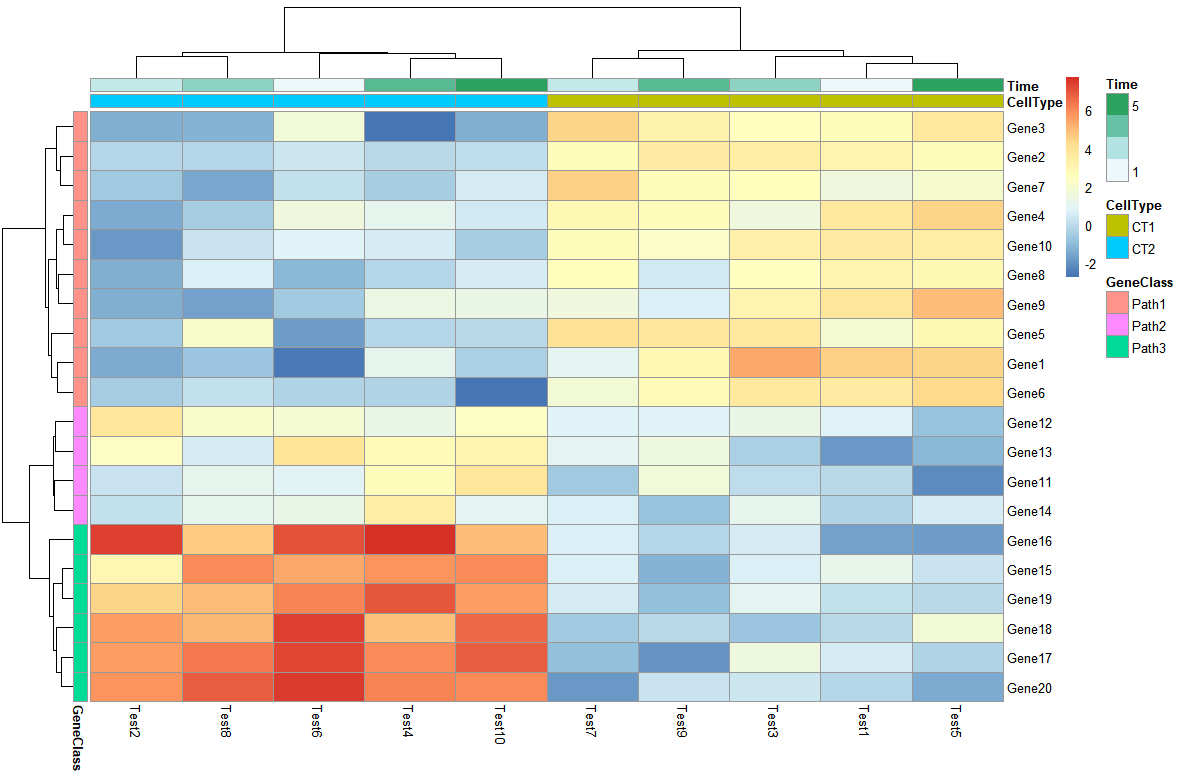
- 对注释信息色块改变配色
> pheatmap(test, annotation_col = annotation_col, annotation_row = annotation_row,
+ annotation_colors = ann_colors)
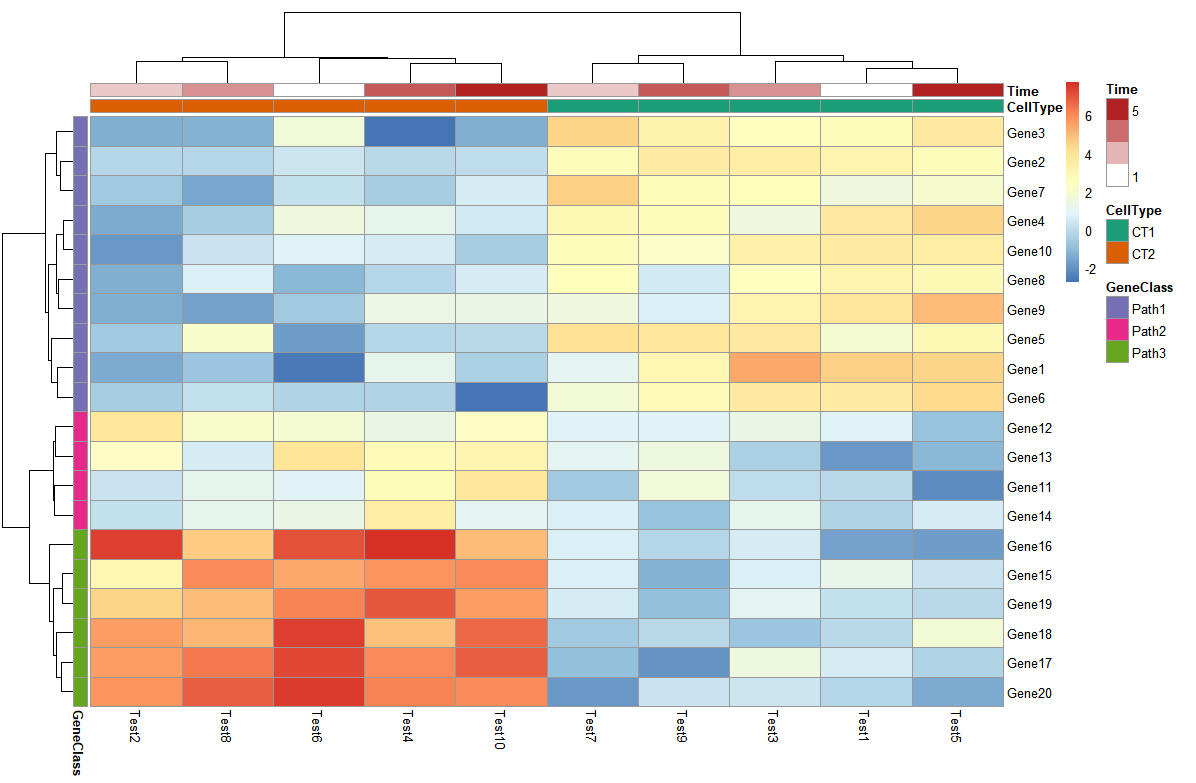
- 把热图分块
> pheatmap(test, annotation_col = annotation_col, cluster_rows = FALSE, gaps_row = c(10, 14),
+ cutree_col = 2)
gaps_row 对行进行分割,c(10,14)即以10和14为分割线,把行分成3部分
cutree_col 对列进行分割,2即分割成两块
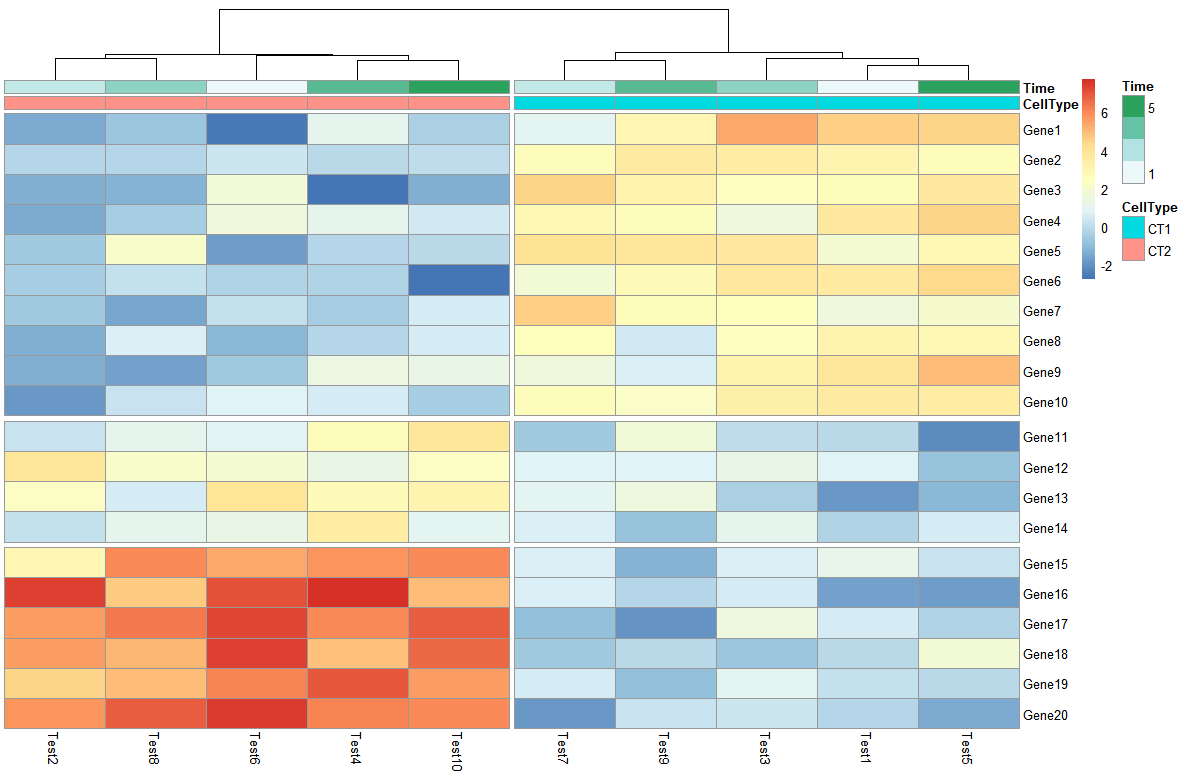
- 改变热图行列名
可以创建新的向量存储想要设置的行列名,传给label_row这个参数
> labels_row = c("", "", "", "", "", "", "", "", "", "", "", "", "", "", "",
+ "", "", "Il10", "Il15", "Il1b")
> pheatmap(test, annotation_col = annotation_col, labels_row = labels_row)
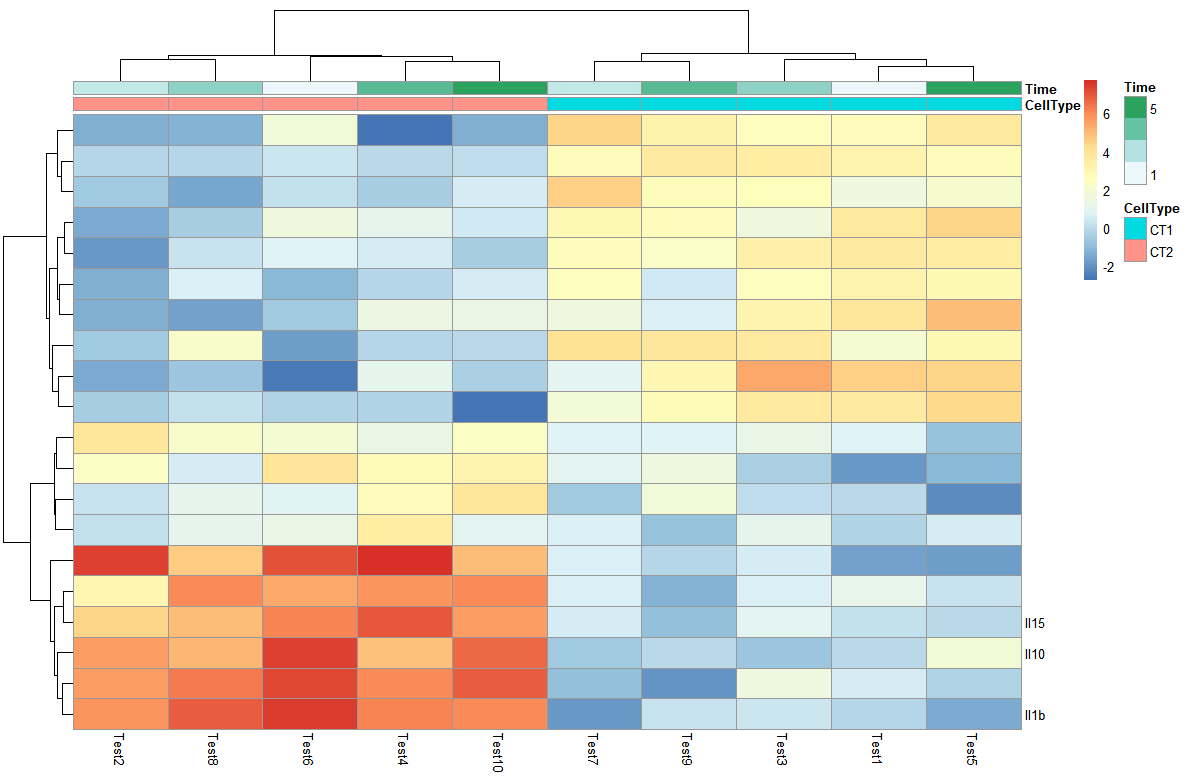
- 热图排序
> callback = function(hc, mat){
+ sv = svd(t(mat))$v[,1]
+ dend = reorder(as.dendrogram(hc), wts = sv)
+ as.hclust(dend)
+ }
> pheatmap(test, clustering_callback = callback)
解决问题1:色块控制
很多情况下,我们需要直观的通过颜色去看,当数据呈现正负值范围内时,理想情况是以0为白色,另外两个色系分别代表正值和负值,一眼看上去容易读图。
以test之间的相关系数矩阵为例,查看一下取值范围:
> library(Hmisc)
> cortest <- rcorr(as.matrix(test), type = "pearson")
> r_value <- cortest$r
> range(r_value)
[1] -0.8980495 1.0000000
设置色块(是通过对称性将0设置为白色)
> pheatmap(r_value,
+ color = c(colorRampPalette(c("blue","white"))(10),
+ colorRampPalette(c("white","red"))(10)),
+ legend_breaks=seq(-1,1,0.2))
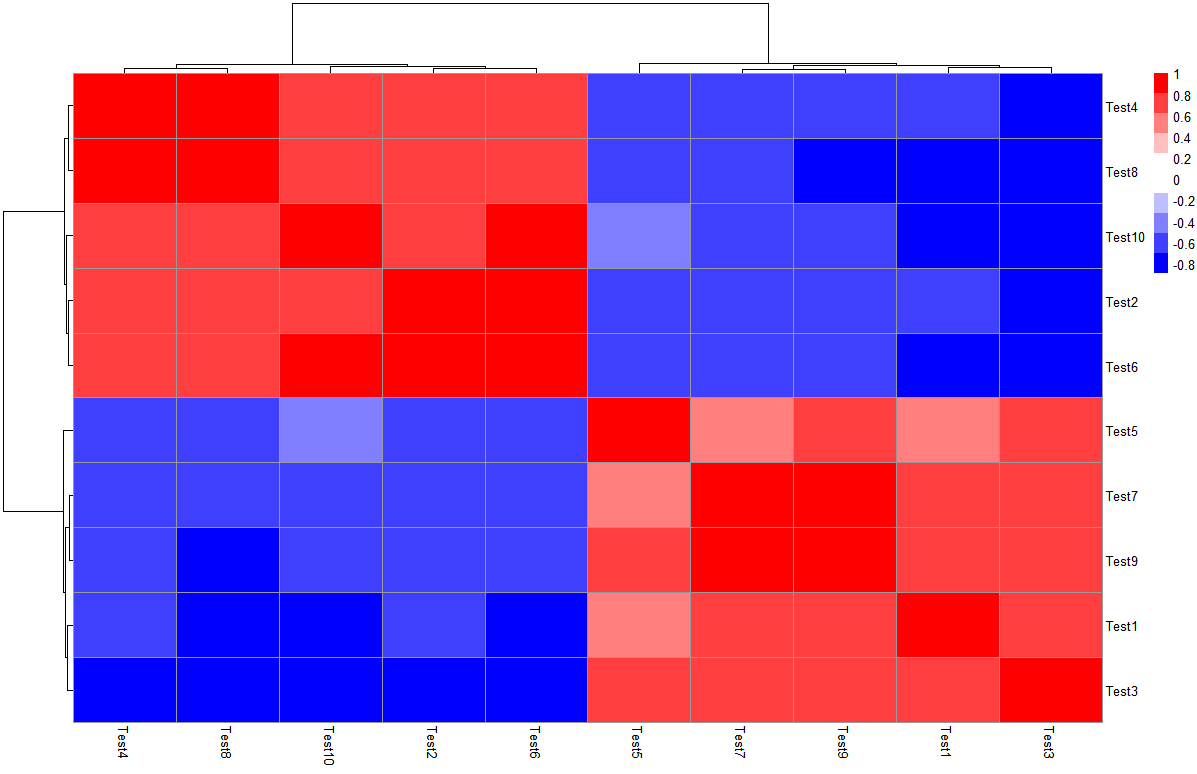
解决问题2:显示部分热图
pheatmap这个包使用的数据形式是矩阵,在变量内部进行相关分析时,有一半数据冗余,但是矩阵形式只能通过test[upper.tri(test)] <- NA将冗余信息变成0,并不能够直接去除,似乎参数里也没有可以直接画上下三角热图的参数,还是可以画出上下三角的热图。
【若使用ggplot2进行热图绘制,由于其输入数据为长数据,可以通过reshape包中的melt()将数据转化,进行绘制】
> r_value[upper.tri(r_value)] <- 0
> pheatmap(r_value,
c(colorRampPalette(c("blue","white"))(5),
colorRampPalette(c("white","red"))(5)),
legend_breaks=seq(-1,1,0.2),
cluster_rows=F, cluster_cols=F, border_color=NA)
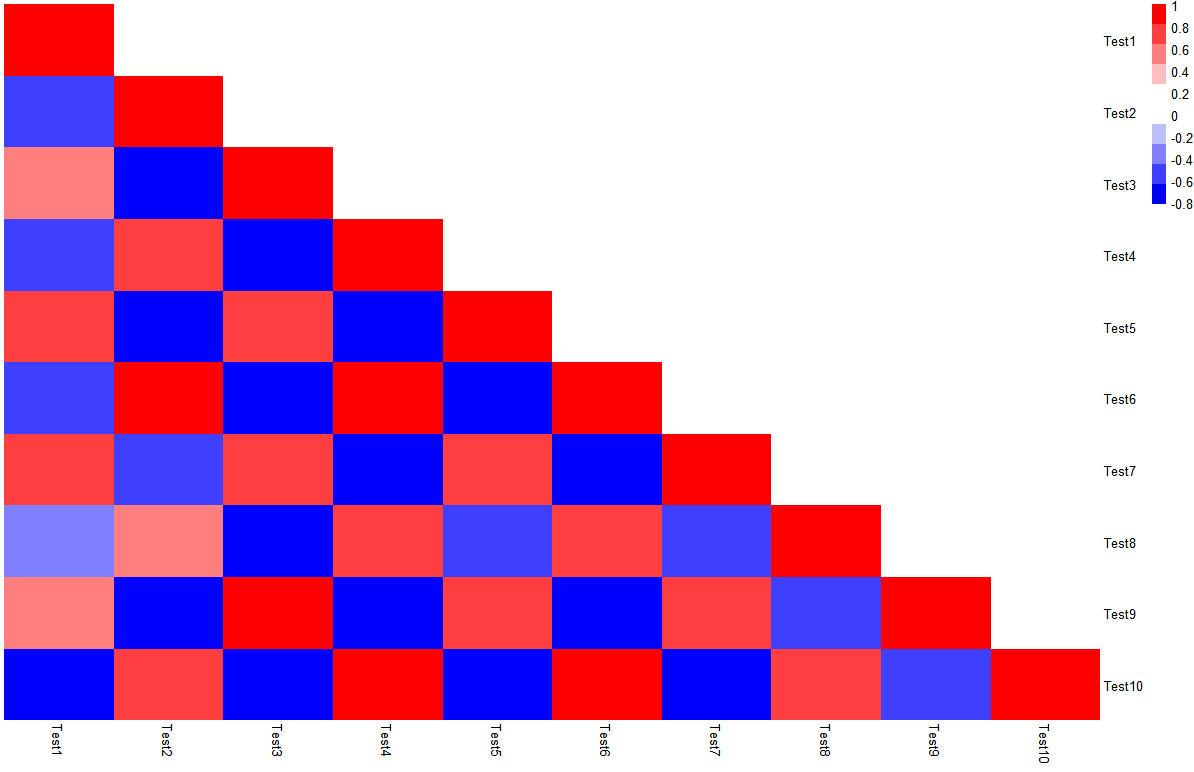
但是这样有一个大BUG,就是数据本身还是存在的,而且要把去掉的三角矩阵部分变成白色色块对应的值。
解决问题3:标记相关系数热图显著性
这里引入一个计算相关矩阵的包Hmisc,可以计算相关性矩阵,随后直接用相关矩阵进行热图绘制,再根据display_numbers参数进行显著性标注。
假设现在我想看这10个test之间相关关系热图:
> library(Hmisc)
> cortest <- rcorr(as.matrix(test), type = "pearson")
> p_value <- ifelse(is.na(cortest$P), "", cortest$P)
> pheatmap(cortest$r, display_numbers = matrix(ifelse(p_value < 0.05, "*", ""), nrow(p_value)))
做相关的type可以选择spearman
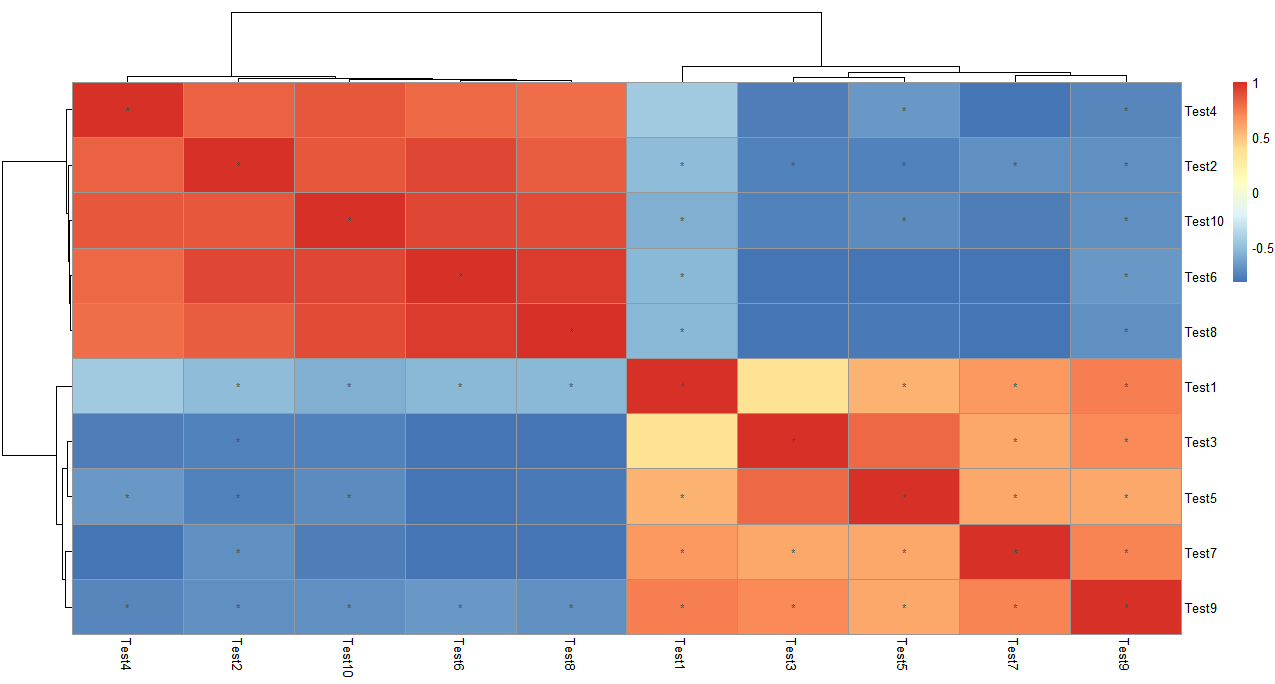
同样的,如果想看这20个基因之间的相关关系热图,可以讲数据框进行转置t(),因为该计算相关矩阵的函数默认对列的变量进行相关分析。
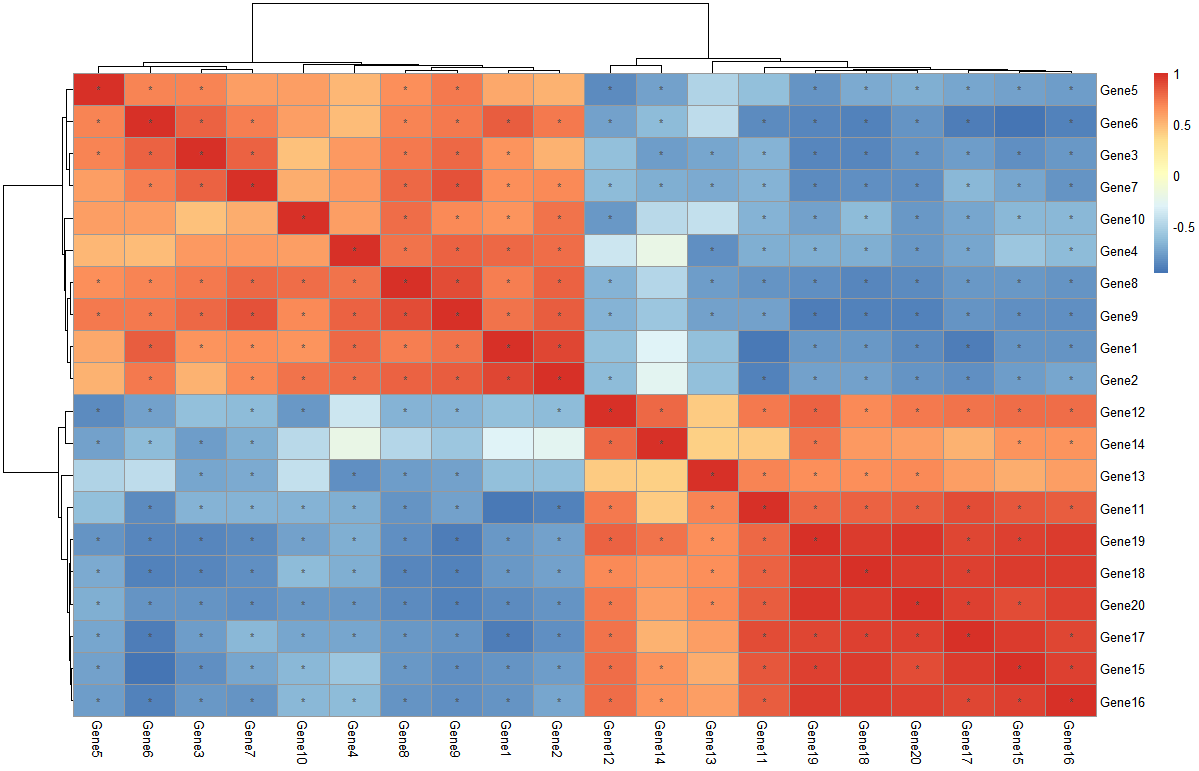
解决问题4:取对数
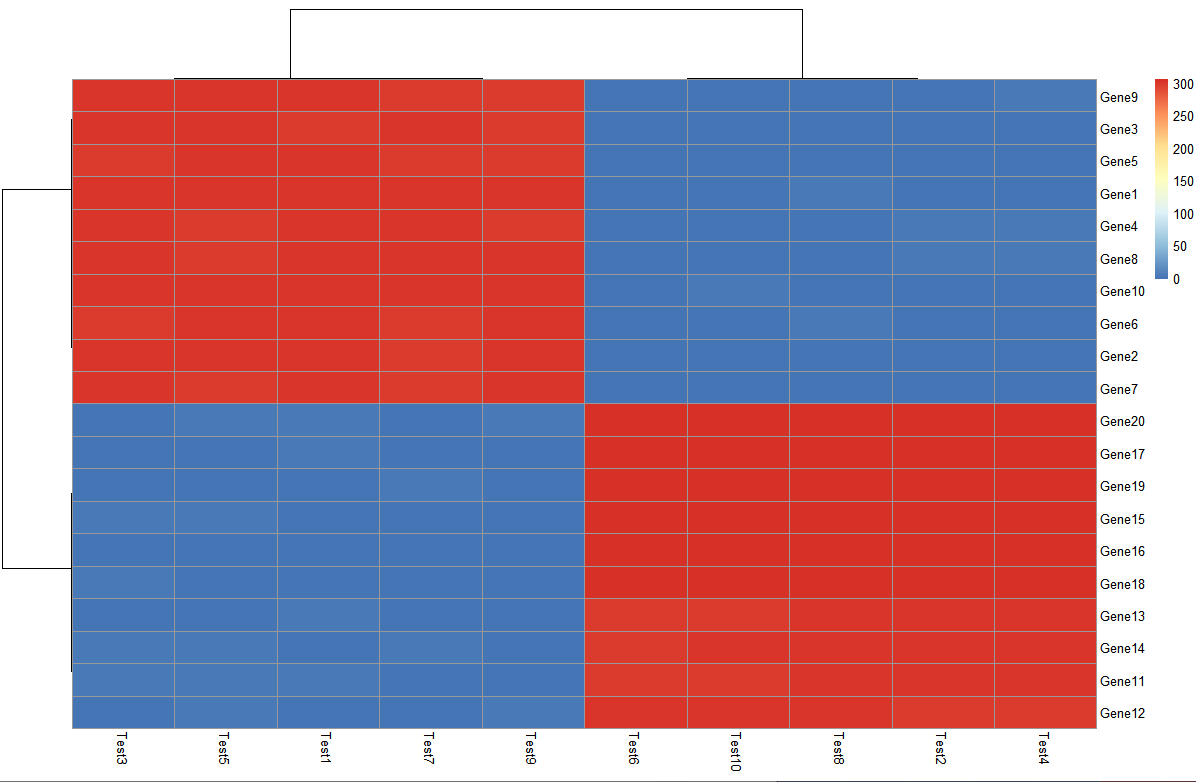
> pheatmap(log10(test))
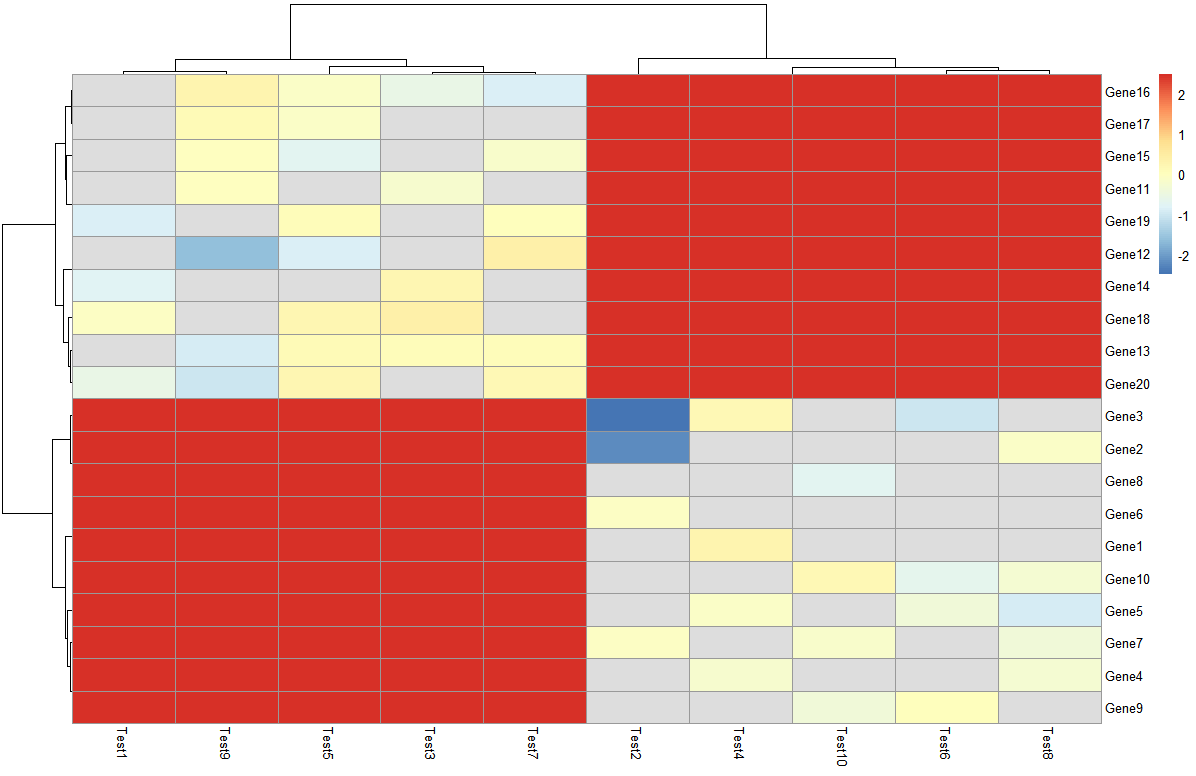
解决问题5:配色
> library("RColorBrewer")
> display.brewer.all()
> brewer.pal.info
maxcolors category colorblind
BrBG 11 div TRUE
PiYG 11 div TRUE
PRGn 11 div TRUE
PuOr 11 div TRUE
RdBu 11 div TRUE
RdGy 11 div FALSE
RdYlBu 11 div TRUE
RdYlGn 11 div FALSE
Spectral 11 div FALSE
Accent 8 qual FALSE
Dark2 8 qual TRUE
Paired 12 qual TRUE
Pastel1 9 qual FALSE
Pastel2 8 qual FALSE
Set1 9 qual FALSE
Set2 8 qual TRUE
Set3 12 qual FALSE
Blues 9 seq TRUE
BuGn 9 seq TRUE
BuPu 9 seq TRUE
GnBu 9 seq TRUE
Greens 9 seq TRUE
Greys 9 seq TRUE
Oranges 9 seq TRUE
OrRd 9 seq TRUE
PuBu 9 seq TRUE
PuBuGn 9 seq TRUE
PuRd 9 seq TRUE
Purples 9 seq TRUE
RdPu 9 seq TRUE
Reds 9 seq TRUE
YlGn 9 seq TRUE
YlGnBu 9 seq TRUE
YlOrBr 9 seq TRUE
YlOrRd 9 seq TRUE
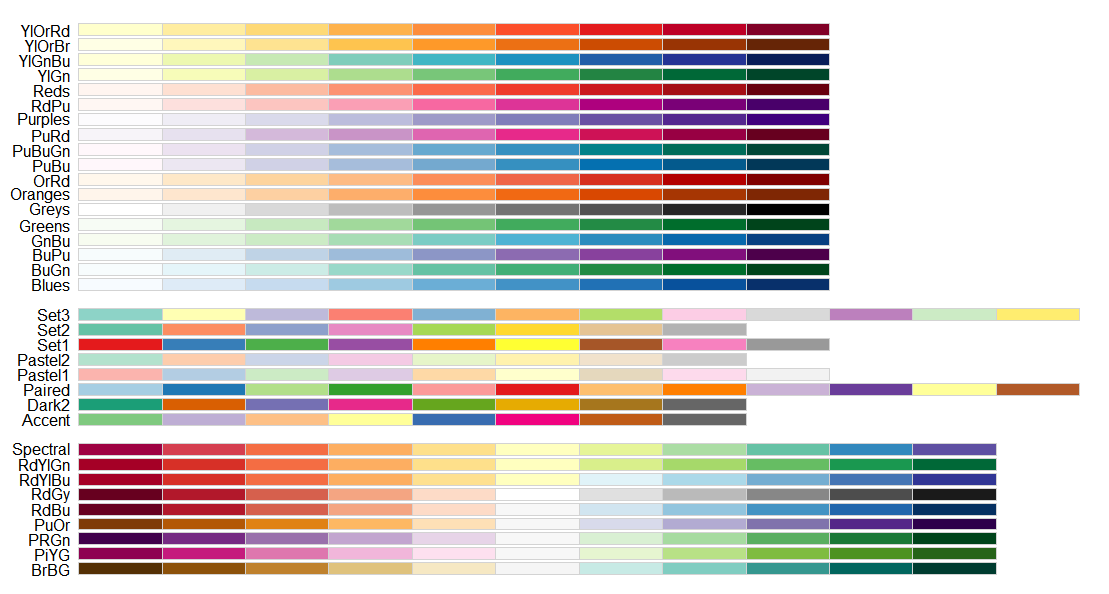
查看具体颜色
> display.brewer.pal(n = 9, name = 'YlOrBr')
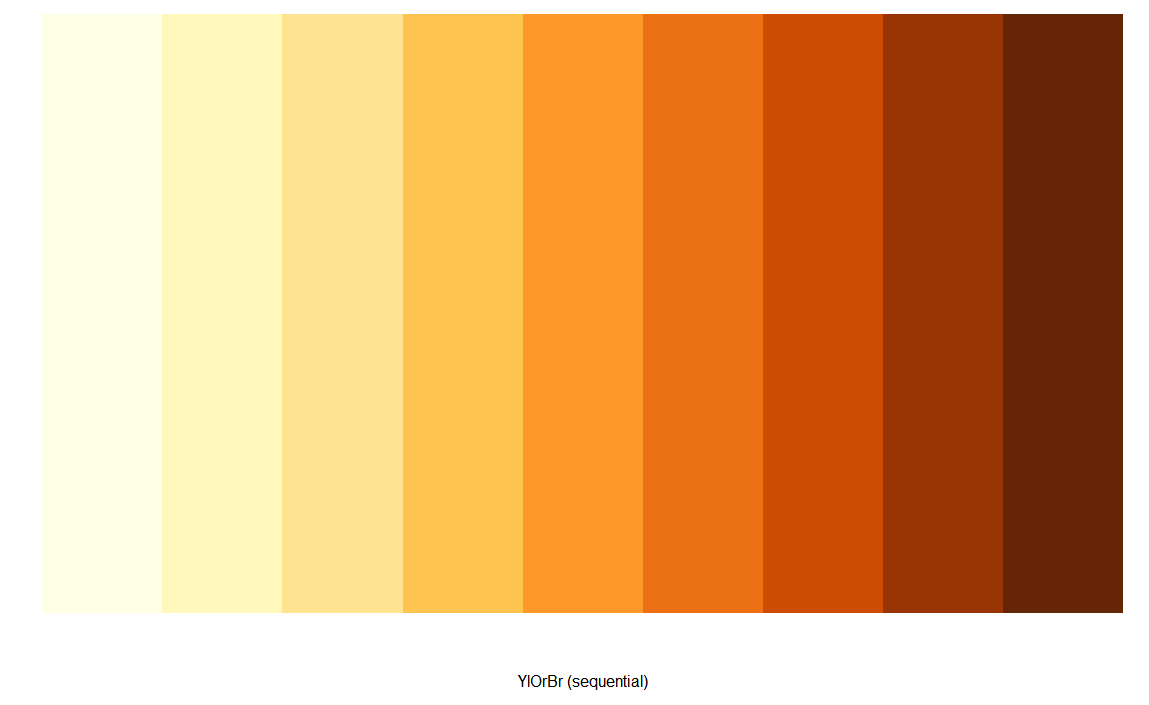
补充
- ComplexHeatmap提供一个新功能,把pheatmap直接转成ComplexHeatmap
source:https://jokergoo.github.io/2020/05/06/translate-from-pheatmap-to-complexheatmap/
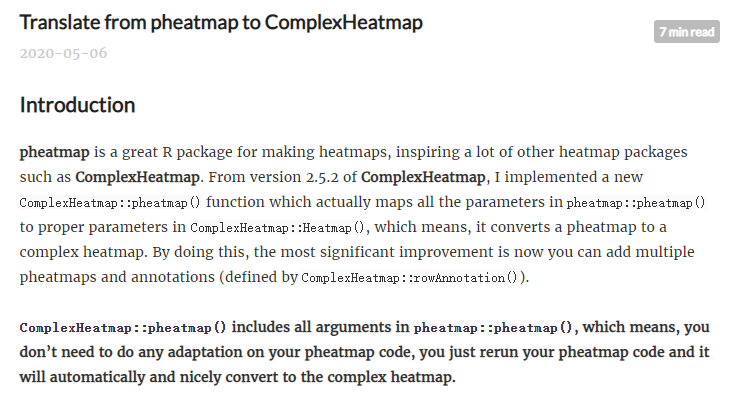
- 使用corrplot包去做相关性热图也是一个很好的选择。